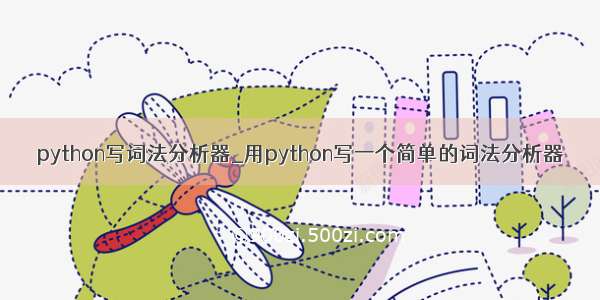
这大概是全网最简陋的词法分析器……学了一点python后上手的第一个小实验。
实验要求粘在下面了,但是实现过程中我根据自己想法做了一些修改。
一、实验目的:
设计并实现一个包含预处理功能的词法分析程序,加深对编译中词法分析过程的理解。
二、实验要求:
1.实现预处理功能
源程序中可能包含有对程序执行无意义的符号,要求将其剔除。
首先编制一个源程序的输入过程,从键盘、文件或文本框输入若干行语句,依次存入输入缓冲区(字符型数据);然后编制一个预处理子程序,去掉输入串中的回车符、换行符和跳格符等编辑性文字;把多个空白符合并为一个;去掉注释。
2.实现词法分析功能
输入:所给文法的源程序字符串。
输出:
二元组(syn,token或sum)构成的序列。其中,
syn为单词种别码。
Token为存放的单词自身字符串。
Sum为整型常量。
具体实现时,可以将单词的二元组用结构进行处理。
3.待分析的C语言子集的词法
关键字
main if then while do static int double struct break else long switch case typedef char return const float short continue for void default sizeof do
所有的关键字都是小写。
运算符和界符
+ - * / : := < <> <= > >= = ; ( ) #
其他标记ID和NUM
通过以下正规式定义其他标记:
ID→letter(letter|digit)*
NUM→digit digit*
letter→a|…|z|A|…|Z
digit→0|…|9…
空格由空白、制表符和换行符组成
空格一般用来分隔ID、NUM、专用符号和关键字,词法分析阶段通常被忽略。
4.各种单词符号对应的种别码
单词符号
种别码
单词符号
种别码
main
1
;
41
if
2
(
42
then
3
)
43
while
4
int
7
do
5
double
8
static
6
struct
9
ID
25
break
10
NUM
26
else
11
+
27
long
12
-
28
switch
13
*
29
case
14
/
30
typedef
15
**
31
char
16
==
32
return
17
<
33
const
18
<>
34
float
19
<=
35
short
20
>
36
continue
21
>=
37
for
22
=
38
void
23
[
39
sizeof
24
]
40
#
0
源代码:
import re
import sys
#关键字,百度百科上复制来的63个关键字……
key_word = ['asm','do','if','return','typedef','auto','double','inline','short','typeid','bool',
'dynamic_cast','int','signed','typename','break','else','long','sizeof','union','case',
'enum','mutable','static','unsigned','catch','explicit','namespace','static_cast',
'using','char','export','new','struct','virtual','class','extern','operator','switch',
'void','const','false','private','template','volatile','const_cast','float','protected',
'this','wchar_t','continue','for','public','throw','while','default','friend','register'
'true','delete','goto','reinterpret_cast','try']
#一些常用函数,不然老被识别为标识符,目前是16个
function_word = ['cin','cout','scanf','printf','abs','sqrt','isalpha','isdigit','tolower','toupper'
'strcpy','strlen','time','rand','srand','exit']
operator = ['+','-','*','/',':',':=','','<=','>','>=','=',';','(',')','#','==','{','}',',','&','[',']',"'"]
with open('cpp.txt', 'w') as file:
print("请输入需要进行词法分析的源程序:")
txt = sys.stdin.readlines()
file.writelines(txt)
with open('cpp.txt', 'r') as file:
#预处理,增加了去除字符串的功能,毕竟字符串肯定不是标识符啊……
txt = ' '.join(file.readlines())
deal_txt = re.sub(r'/\*(.|[\r\n])*?\*/|//.*', ' ', txt)
deal_txt = re.sub(r'\"(.|[\r\n])*?\"', ' ', txt)
deal_txt = deal_txt.strip()
deal_txt = deal_txt.replace('\t', ' ').replace('\r', ' ').replace('\n', ' ')
#词法分析,标识符识别规则加入了_
keyword = []
funword = []
opeword = []
idword = []
numword = []
errword = []
pha = re.findall(r'[a-zA-Z_][a-zA-Z0-9_]*', deal_txt)
num = re.findall(r'\d+',deal_txt)
str = re.findall(r'[^\w]', deal_txt)
for p in pha:
if p in key_word:
keyword.append({p : key_word.index(p) + 1})
elif p in function_word:
funword.append({p : len(key_word) + function_word.index(p) + 1})
else:
idword.append({p : 80})
for n in num:
numword.append({n : 81})
for s in str:
if s in operator:
opeword.append({s: len(key_word) + len(function_word) + operator.index(s) + 3})
elif s != ' ':
errword.append({s : 'ERROR'})
print("关键字:\n", keyword)
print('函数:\n', funword)
print("ID:\n", idword)
print("数字:\n", numword)
print("运算符与界符:\n", opeword)
if len(errword) != 0:
print("其他:\n", errword)
















